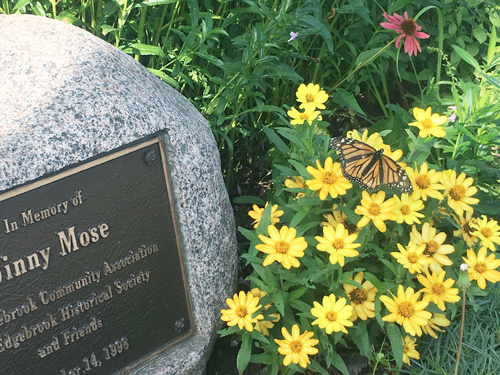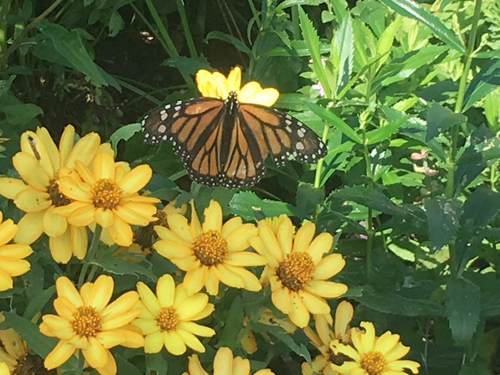Edgebrook Community Association | PO Box 46591 | Chicago IL 60646

The Triangle Garden has been the focus of the Edgebrook Community Association's Beautification Team for the last 5 years. ECA members contribute to this work through the annual dues they pay, and their support is crucial to the overall efforts to improve our public greenspaces.
The Monarch Watch and Monarch Joint Venture, in conjunction with Xerces Society, recognized the ECA's efforts to restore Monarch habitats and certified the garden as a Monarch Waystation.
The transformation into a Butterfly garden began when the Beautification Team reduced the overall garden area of the Triangle to a manageable size and introduced new plants. As a Monarch Waystation, the ECA's garden now offers butterflies the nectar and host plants required for their survival.


Two key plant groups support butterflies throughout their lifecycle.
NECTAR PLANTS provide a food source for adult butterflies. A range of plants are needed to support the Monarch migrations – north in early summer and south to Mexico in late summer. Spring plants include bee balm, daisies, and veronica. For late summer migrations there are golden rod, cone flowers, phlox, rubeckia, liatris, iron weed and others.
HOST PLANTS give a home to butterfly eggs. Each butterfly species requires a unique host plant to lay their eggs and provide food for their caterpillars to eat. Monarch caterpillars only eat milkweed, while swallowtails require fennel, parsley or rue. All are now found in the Triangle Garden.
Milkweed is the only plant that Monarchs can lay their eggs on and it is rapidly disappearing. Only some of the 10 varieties of milkweed can be used by monarchs. Many milkweed are invasive, spreading through roots underground. However two types commonly found in Chicago nurseries are butterfly weed (Asclepias tuberosa) and swamp milkweed (Asclepias incarnate). These well-behaved garden plants will not spread and offer monarchs the perfect place to lay their eggs and provide food for their caterpillars. Common milkweed (Asclepias syriaca) is a manageable spreader that is found in our forest preserves and is another good choice for monarchs.
We added these species to the Triangle and have had a bumper crop of eggs this summer. Over 30 caterpillars grew up in the garden this year, all under the ECA's care to protect them from birds to ensure they reach adulthood, thereby adding to the generation that is destined to travel to Mexico in September.
We are excited that wildlife has discovered the Waystation in our corner in the city.
1. Add milkweed to your garden. Butterfly weed and Swamp milkweed are beautiful additions to any garden.
2. Join the ECA with an annual family membership. This easy and important step supports our community's efforts to improve life in our area for us, our children and the wildlife. Please join us and help make Edgebrook a better place to live!
3. Volunteer for Clean & Green Days and keep Edgebrook looking good. Contact us at talk2eca@gmail.com and we'll put you on the standby volunteer list.
Key Elements of a Monarch Butterfly Garden
Create a Butterfly Garden in a Pot
Great info on milkweed: Forest Preserve link
Pick the right milkweed: Botanic Garden link
FIELD MUS: Monarch Butterflies:101